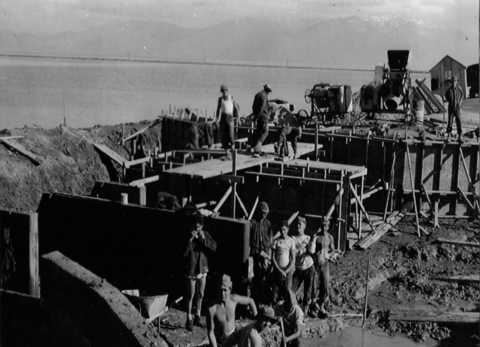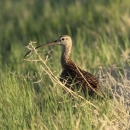About Us
Each unit of the National Wildlife Refuge System is established to serve a statutory purpose that targets the conservation of native species dependent on its lands and waters. All activities on those acres are reviewed for compatibility with this statutory purpose.
Established in 1928 by Congress (Public Law 304) and the initial boundaries designated by Presidential Proclamation (2011) in 1932, Bear River Migratory Bird Refuge was one of the first refuges to join a system of lands now encompassing over 560 refuges in the National Wildlife Refuge System - a network of lands set aside and managed by the U.S. Fish & Wildlife Service specifically for wildlife. The Refuge and other wetlands associated with the Great Salt Lake provide critical habitat for migrating birds, over 250 species moving through this area annually by the millions to rest and feed. As part of the Bear River Bay, the Refuge is designated as a Western Hemisphere Shorebird Reserve Network site, a globally important shorebird area.
The Refuge lies along the eastern edge of the Pacific Flyway and the western edge of the Central Flyway, making it an important resting, feeding, and nesting area for birds in both flyways. Of more than 250 bird species that use the refuge, 67 species nest on the Refuge. American avocets and black-necked stilts nest by the thousands along Refuge dikes and roads. White-faced ibis nest in dense emergent vegetation in large colonies of up to 10,000 birds. Migrant tundra swans can number in the tens of thousands in the spring and fall. The Refuge uses a complex system of dikes and water control structures to provide different water depths for a variety of waterbird species over the seasons.
On the ancestral homelands of the Shoshone, Paiute, Bannock, and Ute people known as the Newe or Meme (the People), the Refuge lands and waters support diverse plant and animal species in a mosaic of mudflats, river deltas, brackish and freshwater marshes, temporary ponds, and uplands. Refuge uplands have scattered knolls that form a unique ecological community in the Bear River delta.
Today, Bear River Migratory Bird Refuge contains nearly 80,000 acres of marsh, open water, uplands, and alkali mudflats. The marshes and open water are managed using a complex system of dikes and water control structures to provide a variety of water depths suitable for the needs of different waterbird species. The Refuge is an excellent place to observe wildlife along a 12-mile auto tour route, as well as enjoying hunting, fishing, and wildlife photography.
Our Mission
Each unit of the National Wildlife Refuge System is established to serve a statutory purpose that targets the conservation of native species dependent on its lands and waters. All activities on those acres are reviewed for compatibility with this statutory purpose.
Bear River Migratory Bird Refuge was established in 1928 by the 70th session of Congress (Public Law 304) and Presidential Proclamation (2011) in 1932, as "a suitable refuge and feeding and breeding grounds for migratory wild fowl".
Bear River Migratory Bird Refuge’s mission is to provide necessary habitats for the provision of food and cover needed to fulfill lifecycle events such as migration, staging, feeding, and breeding of migratory bird species using the Refuge, with an emphasis on focal species and native wildlife. The Refuge conserves and enhances the wetland and upland areas to accomplish these goals. To that end, management actions strive to maximize available habitat for multiple species of migratory birds, while providing for the highest quality of recreational experiences deemed compatible such as hunting, fishing, wildlife observation/photography, and environmental education and interpretation. Water, as the critical element in a wetland habitat, comes in short supply to the arid west and must be carefully managed.
Our History
In the 1920s, due to the loss of marshes and huge bird die-offs from botulism, local individuals and organizations urged Congress to protect this valuable resource in Northern Utah, and in 1928 the Bear River Migratory Bird Refuge was created. The purpose of the Refuge is to serve as a "suitable refuge and feeding and breeding grounds for migratory waterfowl" (Presidential Proclamation, Public Law 302).
Geologic History
The Great Salt Lake is a product of historic Lake Bonneville that dates back to the Pleistocene period (about 70,000 years ago) during the last ice age. Lake Bonneville occupied 20,000 square miles of area from Milford, Utah, to Malad, Idaho, and held 10 times the current water content of the Great Salt Lake, or the amount of water contained in Lake Michigan. The end of Lake Bonneville and the beginning of the Great Salt Lake began with a breach of Lake Bonneville's containment, causing a catastrophic flood on the Snake River and reducing the water volume in the ancient lake.
-LeRoy W. Hooton, Jr. - September 24, 2010
Human History
Shoshone, Paiute, Bannock, and Ute people used the area prior to European settlement. They called themselves Newe or Neme (the People.) The Newe formed small extended-family groups and were semi-nomadic hunter-gathers. The arrival of Europeans and the introduction of horses, guns, and disease dissolved this social structure structure
Something temporarily or permanently constructed, built, or placed; and constructed of natural or manufactured parts including, but not limited to, a building, shed, cabin, porch, bridge, walkway, stair steps, sign, landing, platform, dock, rack, fence, telecommunication device, antennae, fish cleaning table, satellite dish/mount, or well head.
Learn more about structure and resulted in more formal identities and loyalties.
1903: As European settlers moved into the area, ambitious projects were undertaken to divert great quantities of Bear River water for use by upstream settlements and farms. The marshes began to dry.
1920: Only two or three thousand acres of the original forty-five thousand acres of wetland were left. The loss of wetlands through drying was a serious problem affecting the survival of migrating birds.
1928: Avian botulism created gruesome scenes of hundreds of thousands of dead and dying birds. The public’s reaction to these deadly epidemics brought action, and Congress passed an act to make the Bear River delta a National Wildlife Refuge.
1931: 50 miles of dike and water control structures were completed by the Civilian Conservation Corps (CCC). The CCC was a national voluntary public work relief program for young, unmarried men during the Great Depression. At the Refuge, the CCC built dikes to hold water in wetlands, canals to move water to different parts of the Refuge, and artificial islands to protect nesting birds.
1943: While the concept of airboats had been around since 1905 with Alexander Graham Bell’s design of the “Ugly Duckling,” the airboat design most thought of when talking about modern airboats was invented at Bear River Migratory Bird Refuge in 1943 by Cecil Williams, Leo Young, and G. Hortin Jensen.
1964: A record 79,000 ducklings were produced at Bear River Refuge.
1982: New visitor center was dedicated, and thousands of people came to see the wetlands and birds of the Bear River Delta.
1983: With years of record precipitation, the Great Salt Lake began to rise. The rising water eventually overtook Refuge dikes, contaminating the fresh water habitats with saline lake water, destroying the new visitor center and other structures. In short, the Refuge was rendered inoperable.
1990: As the waters of Great Salt Lake receded, the dikes and remains of buildings became visible. Refuge employees, aided by scores of volunteers, began working to restore the Refuge.
1993: New critical breeding habitat was added to the Refuge. This grassland area near Interstate 15 offers habitat for nesting waterfowl.
1997: Over 1.5 million cubic yards of dirt was moved to restore and improve the old dikes.
2000: The habitat recovered and began supporting millions of birds. The Refuge again became a very crucial component of the Great Salt Lake ecosystem.
2003: The National Wildlife Refuge System celebrated its centennial. Bear River Migratory Bird Refuge celebrated its 75th birthday.
2006: The new visitor education center and office complex opened.
2021: The Habitat Management Plan was approved.
Other Facilities in this Complex
Both Bear River Migratory Bird Refuge and the Fish Springs National Wildlife Refuge have similar habitat conservation needs, and combining these areas assists in providing consistency and effectively utilizing human and capital resources for both locations.
Fish Springs National Wildlife Refuge is located on the southern extreme of the Great Salt Lake Desert and is essential in meeting the needs of humans and wildlife over the past 10,000 years. Most critical are the life-sustaining waters.

